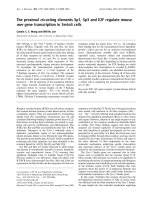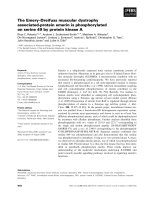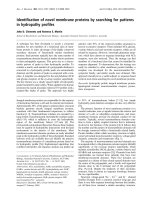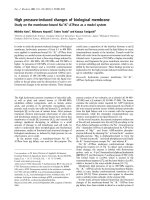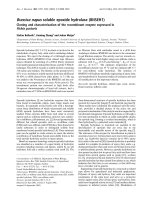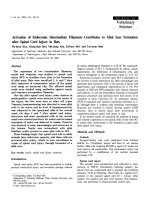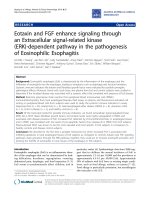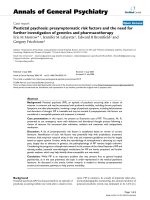Báo cáo y học: "Ipsilateral common iliac artery plus femoral artery clamping for inducing sciatic nerve ischemia/reperfusion injury in rats: a reliable and simple method" doc
Bạn đang xem bản rút gọn của tài liệu. Xem và tải ngay bản đầy đủ của tài liệu tại đây (678.1 KB, 4 trang )
BioMed Central
Page 1 of 4
(page number not for citation purposes)
Journal of Brachial Plexus and
Peripheral Nerve Injury
Open Access
Short report
Ipsilateral common iliac artery plus femoral artery clamping for
inducing sciatic nerve ischemia/reperfusion injury in rats: a reliable
and simple method
Mohsen Nouri
1
, Reza Rahimian
1
, Gohar Fakhfouri
2
, Mohammad R Rasouli
1
,
Sanaz Mohammadi-Rick
1
, Anita Barzegar-Fallah
1
, Fahimeh Asadi-Amoli
3
and
Ahmad Reza Dehpour*
1
Address:
1
Department of pharmacology, Tehran University of Medical Sciences, Tehran, Iran,
2
Department of pharmacology, Shahid Beheshti
University of Medical Science, Tehran, Iran and
3
Department of pathology, Tehran University of Medical Sciences, Tehran, Iran
Email: Mohsen Nouri - ; Reza Rahimian - ; Gohar Fakhfouri - ;
Mohammad R Rasouli - ; Sanaz Mohammadi-Rick - ; Anita Barzegar-
Fallah - ; Fahimeh Asadi-Amoli - ; Ahmad Reza Dehpour* -
* Corresponding author
Abstract
The aim of this study was to develop a practical model of sciatic ischemia reperfusion (I/R) injury
producing serious neurologic deficits and being technically feasible compared with the current time
consuming or ineffective models. Thirty rats were divided into 6 groups (n = 5). Animal were
anesthetized by using ketamine (50 mg/kg) and xylazine (4 mg/kg). Experimental groups included a
sham-operated group and five I/R groups with different reperfusion time intervals (0 h, 3 h, 1 d, 4
d, 7 d). In I/R groups, the right common iliac artery and the right femoral artery were clamped for
3 hrs. Sham-operated animals underwent only laparotomy without induction of ischemia. Just
before euthanasia, behavioral scores (based on gait, grasp, paw position, and pinch sensitivity) were
obtained and then sciatic nerves were removed for light-microscopy studies (for ischemic fiber
degeneration (IFD) and edema). Behavioral score deteriorated among the ischemic groups
compared with the control group (p < 0.01), with maximal behavioral deficit occurring at 4 days of
reperfusion. Axonal swelling and IFD were found to happen only after 4 and 7 days, respectively.
Our observations led to an easy-to-use but strong enough method for inducing and studying I/R
injury in peripheral nerves.
Background
Ischemia is the subject of investigation in many experi-
mental studies on neuropathies representing neural
changes in diabetes mellitus, vasculitis or vasculopathies,
vascular occlusion by emboli or thrombosis, and trauma.
Histological changes including endoneurial edema,
demyelination, axonal degeneration, and diffuse loss of
nerve fibers as well as behavioral and electro-physiologic
studies are the commonly used measures by researchers to
evaluate the outcome of ischemia/reperfusion (I/R) inju-
ries. Setting up a model that is easily performable and
induces expected para-clinical and clinical changes in the
target organ, is a prerequisite to simulate clinical condi-
tions under laboratory circumstances.
Published: 22 December 2008
Journal of Brachial Plexus and Peripheral Nerve Injury 2008, 3:27 doi:10.1186/1749-7221-3-27
Received: 29 September 2008
Accepted: 22 December 2008
This article is available from: />© 2008 Nouri et al; licensee BioMed Central Ltd.
This is an Open Access article distributed under the terms of the Creative Commons Attribution License ( />),
which permits unrestricted use, distribution, and reproduction in any medium, provided the original work is properly cited.
Journal of Brachial Plexus and Peripheral Nerve Injury 2008, 3:27 />Page 2 of 4
(page number not for citation purposes)
Various models of unilateral I/R injury of rat sciatic nerve
have been developed. In one method described by Mitsui
et al. [1], the abdominal aorta, the right iliac and femoral
arteries, and all identifiable collateral vessels supplying
the right sciatic-tibial nerve are ligated for 3 hrs and then
reperfused for different time intervals. In another model
introduced by Saray and his colleagues [2], only femoral
artery and vein – just distal to the inguinal ligament – are
clamped for 3 hrs followed by reperfusion. The former is
time consuming and requires advanced surgical tech-
niques and instruments and the latter, albeit easily per-
formable, does not produce severe injury [3]. The aim of
this study was to develop a practical model producing
serious neurologic deficits and still technically feasible.
For this purpose, clamping of both the femoral artery and
ipsilateral common iliac artery was performed to induce
sciatic nerve I/R.
Materials and methods
Thirty Spraque-Dawley male rats were housed in a tem-
perature-controlled room (25 ± 1°C) and maintained on
a 12 h light/dark cycle with free access to food and water.
All experiments were performed in accordance with insti-
tutional guidelines for animal care and use and also "Prin-
ciples of laboratory animal care" were followed. The
animals weighing 150–200 g were randomly divided into
six groups: one control group and five I/R groups at differ-
ent time intervals of reperfusions (0 h, 3 h, 1 d, 4 d, 7 d).
All animals were anesthetized with ketamine (50 mg/kg)
and xylazine (4 mg/kg) and subjected to laparotomy. In
the I/R groups, the right common iliac artery and the right
femoral artery – just distal to the inguinal ligament – were
clamped for 3 hrs using two Yasargil aneurysm clips pro-
viding 125 g (1.24 N) force. Reperfusion was checked
under a microscope at the distal site of clamping after
removing the clips. Using a rectal probe inserted 5 cm into
the rectum, the deep rectal temperature was monitored
and maintained at 36.5 ± 1°C by a thermal pad. All pro-
cedures were carried out for the sham-operated group
except for arterial clamping. After certain time intervals of
reperfusion, the function of the hind limb was assessed
for each animal in terms of behavioral score based on gait,
grasp, paw position, and pinch sensitivity, while the score
for each index varied from 0 (no function) to 3.0 (normal
function) except for pinch sensitivity ranging from 0 to 2
[4]. Behavioral scoring was performed by two separate
observers blinded to the status of the rats and the average
scores were recorded. Then, the sciatic nerve was fixed in
situ for 30 min using 4% formaldehyde in phosphate
buffer (pH 7.4) and then, trifurcation of the sciatic nerve
was removed, embedded in paraffin, and finally, sections
were stained with hematoxylin, eosin and tri-chrome
gomori for light-microscopy studies, and were graded for
ischemic fiber degeneration (IFD) and edema [5]. The sec-
tions were graded 0 to 4 for IFD based on the percentage
of IFD as follows: ≤ 2%, 3–25%, 26–50%, 51–75%, and
>75%, respectively (Table 1). Three sections in row from
each specimen and three random fields at high power
field (HPF) level from each section were chosen and the
results were averaged. Grading for edema was based on
severity and distribution, where 0 = normal, 1 = mild
edema, 2 = moderated edema, 3 = severe edema, and 4 =
severe and widespread edema (Table 1).
Non-parametric Kruskal-Wallis (KW) and Mann-Whitney
U (MWU) tests were used to compare behavioral and
pathologic scores (i.e. edema and IFD grades) among the
groups. Data throughout the manuscript are presented as
median. All statistical analyses were performed utilizing
the SPSS software, version 13.0.
Results
Using KW test, behavioral, IFD, and edema scores of I/R
groups differed significantly from those of control (p <
0.01, p < 0.001, and p < 0.001 respectively). Behavioral
assessment was not reliable in 0 h reperfused group,
because the animals were still under the effect of anes-
thetic drugs which would interfere with the behavioral
outcome. Behavioral function was normal in control
group (total score = 11) at any given time. Loss of function
was observed in all I/R groups compared with control
(group 3 h: score 3.00; group 1 d: score 6.00; group 4 d:
score 4.00; group 7 d: score 6.00; MWU, p < 0.01 vs. con-
trol) (Fig. 1A). Animals at 4 days showed the worst behav-
ioral outcome, though this was not statistically significant
(MWU, p > 0.05). Pathologic changes were significant in
the reperfused groups compared with control group (Fig.
2). Fiber degeneration was observed only in group 7 d
(group 7 d; 3.00; MWU, p < 0.01) (Fig. 1B). Epineural
Table 1: Histopathological scoring system for quantification of edema and Ischemia Fiber Degeneration (IFD)
Histopathologic grade Edema IFD (ischemic fiber degeneration)
0normal ≤ 2%
1 Mild edema 3–25%
2 Moderate edema 26–50%
3 Severe edema 51–75%
4 Severe and widespread edema >75%
Journal of Brachial Plexus and Peripheral Nerve Injury 2008, 3:27 />Page 3 of 4
(page number not for citation purposes)
edema was observed from day 1 on, but marked endone-
ural edema occurred at 4 (group 4 d; 2.00; MWU, p <
0.01) and 7 days (group 7 d; 4.00; MWU, p < 0.01) (Fig.
1C). Specimens from group 7 d had more severe edema
compared with group 4 d (MWU, p < 0.05).
Discussion
The results of our experiment promised of a newly intro-
duced method for induction of I/R injury in peripheral
nerve. Our method produced profound ischemic changes
at light microscopic level with its maximal effect elicited
at 7 days and a considerable behavioral deficit with its
peak at 4 days.
In previous studies, three phases were reported at the light
microscopic level [4,6]. The first phase was reportedly
happens in 0 h and 3 h groups and did in our study with
only minimal axonal changes observed. Group 1 d in our
study also showed slight edema, being mostly epineurial,
but still no noticeable endoneurial changes. The second
phase in our study was also in concordance with the afore-
mentioned studies showing IFD and profound axonal
edema at 7 days. Iida [4] also reported a third phase of
fiber regeneration with only minimal edema and fiber
debris at 28 and 42 days of reperfusion; but, as our study
included groups up to 7 days, changes of third phase were
not observed.
Regarding the behavioral score, our results were slightly
different from the previous models. Iida et al. reported
maximal behavioral deficit to happen at day 7 of reper-
fusion, while in our model this occurred at day 4 with a
slight recovery at day 7. As Iida and his colleagues' study
did not include a 4 day group, we can not make a judg-
ment whether our model induces an earlier maximal defi-
ciency. They used a 20 score scale to investigate behavioral
performance and observed score 4 at 7 days (20% of the
max) while in our study score 6 of an 11 score scale (54%
of the max) was seen at 7 days. Although, inter-observer
bias should be taken into consideration, it seems that our
Behavioral score, the grade of IFD, and edemaFigure 1
Behavioral score, the grade of IFD, and edema. (A) Behavioral score worsens as time passes with the worst outcome at
4 days. (B) IFD occurred only after 7 days of reperfusion while (C) edema happened earlier at 4 days, but was still more severe
at 7 days.
Slides stained with tri-chrome gomori from control group (left panel) and group 7 days reperfusion (right panel) at light microscopy levelFigure 2
Slides stained with tri-chrome gomori from control
group (left panel) and group 7 days reperfusion (right
panel) at light microscopy level. There were axonal
swelling, and fiber degeneration at 7 days compared with
control group.
Publish with BioMed Central and every
scientist can read your work free of charge
"BioMed Central will be the most significant development for
disseminating the results of biomedical research in our lifetime."
Sir Paul Nurse, Cancer Research UK
Your research papers will be:
available free of charge to the entire biomedical community
peer reviewed and published immediately upon acceptance
cited in PubMed and archived on PubMed Central
yours — you keep the copyright
Submit your manuscript here:
/>BioMedcentral
Journal of Brachial Plexus and Peripheral Nerve Injury 2008, 3:27 />Page 4 of 4
(page number not for citation purposes)
model failed to induce a neurologic deficiency so severe as
the above-mentioned method. This could be explained by
the extent of arteries cross clamped in their method. In
spite of this difference, the simplicity of our modified
method and its still-considerable induced functional
defect in the limb make it rational to apply in experimen-
tal studies.
Briefly, our results show that common iliac artery and
femoral artery clamping induces I/R injury in rat sciatic
nerve. This method provides the obvious advantage of
producing an easily induced moderate to severe behavio-
ral deficit over the current methods and can be used in
experimental studies designed to evaluate the effect of
therapeutic candidates on I/R injury in peripheral nerves.
Competing interests
The authors declare that they have no competing interests.
Authors' contributions
MN participating in drafting the manuscript. RR partici-
pating in drafting the manuscript and statistical analysis.
GF participating in statistical analysis and study design.
MRR: Preparing the revised paper and drafting the manu-
script. SMR participating in setting up the method.
ABF participating in setting up the method. FAA carried
out pathologic assessment.
ARD participated in the design and cordination of the
study. All authors read and approved the manuscript.
References
1. Mitsui Y, Schmelzer JD, Zollman PJ, et al.: Hypothermic neuropro-
tection of peripheral nerve of rats from ischaemia-reper-
fusion injury. Brain 1999, 122(Pt 1):161-169.
2. Saray A, Can B, Akbiyik F, et al.: Ischemia-Reperfusion injury of
the peripheral nerve: an experimental study. Microsurg 1999,
19:374-380.
3. Nouri M, Rasouli M, Rahimian R, et al.: Femoral vessels cross-
clamping: the reliability of a method for sciatic nerve
ischemia-reperfusion injury. Microsurg 2007, 27(3):206-207.
4. Iida H, Schmelzer JD, Schmeichel AN, et al.: Peripheral nerve
ischemia: reperfusion injury and fiber degeneration. Exp Neu-
rol 2003, 184:997-1002.
5. Kihara M, Zollman PJ, Schmelzer JD, et al.: The influence of dose of
microspheres on nerve blood flow, electrophysiology, and
fiber degeneration of rat peripheral nerve. Muscle Nerve 1993,
16:1383-1389.
6. Zollman PJ, Awad O, Schmelzer JD, et al.: Effect of ischemia and
reperfusion in vivo on energy metabolism of rat sciatic-tibial
and caudal nerves. Exp Neurol 1991, 114:315-320.
